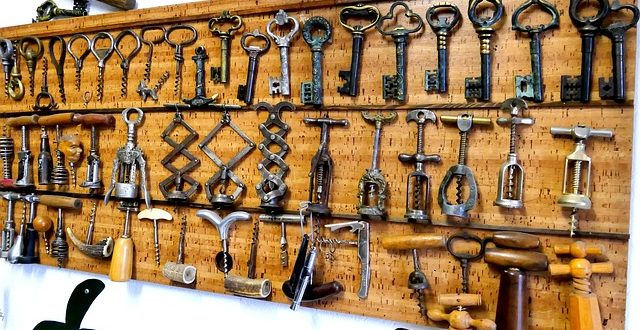Cork has been used to seal wine bottles since the 1700’s, this coincided with the availability of uniform glass bottles. It seems that corkscrews came a bit later, how you got to the wine before is unclear! Cork was a big improvement on the cloth, leather and glass seals that preceded it. By reducing oxidation, wine could now mature for longer giving birth to fine wines.
After several hundred years, the humble cork is under threat, primarily from screw tops which have just about thrown off their budget wine image.
Cork
Cork is a natural and sustainable material from the cork oak (Quercus suber). Every nine years, growers remove and prepare strips of bark. it’s sustainable as new bark grows. A mature tree can produce 200 kg of cork every nine years for as long as 200 years. Portugal and Spain are the main producers.
Standard cork
These come from a single piece of bark. About 24 mm in diameter, it relies on the elasticity of the cork to seal the bottle. These are the most expensive and needed for wines to be stored. They allow a tiny amount of air to enter, playing its part in the ageing process.
Agglomerate cork
By gluing tiny pieces of chopped cork together you produce a cheaper cork for high turnover, quick to drink wines.
Champagne cork
Three pieces of cork are sandwiched together. The mushroom like head sticks out from the top of the bottle, allowing you to get a better grip when easing it out.
Disadvantages of cork
Although we consider natural cork the sign of traditional value and quality, there are drawbacks. Corked wine is the result of fungal contamination, wine tainted with a chemical called trichloroanisole (TCA). This produces a musty, cardboard taste. Particularly with agglomerate corks, you can detect a glue-like aroma or taste tainting the wine.
Corked wine is the reason for the little ceremony in restaurants, where the waiter asks one person at the table to taste the wine. Not to worry, if the wine is corked, you will know! Send it back and get another one.
Cork alternatives
Anxious to remove the risk of wine going off and to save cost, wine producers around the world have been looking for alternatives to cork.
Synthetic cork
These are made from plastic and some resemble natural corks. They lessen the risk of fungal contamination leading to corked wine and save cost. Some argue they look more upmarket compared to screw tops.
There is little evidence on whether they affect the ageing process. They can be more difficult to extract than corks and there’s a risk of damage to the Teflon coating on more expensive corkscrews. We recommend using a butterfly model corkscrew when removing these corks. They are losing ground to screw caps.
Screw cap
The screw cap or Stelvin closure first appeared in the 1950’s. They are efficient, cheap and seal wine effectively, like traditional corks, minute air ingress allows for the ageing process to continue. The downside is the loss of the ritual of removing a cork, gone is the pop as the cork comes out and keeping an aluminium top as a souvenir of a night out is not the same!
For several decades following their introduction their use was confined to budget wines typically drunk at home, a testament to wine snobbery. Since the mid 1990’s, driven by New World producers usage is growing. Some New Zealand vineyards are 100% screw top, now, less buyers are judging a wine by the closure. European producers are less enthusiastic, but there is a sign of change.
Without the drama of a waiter removing a cork and the lack of the characteristic pop, corks are unlikely to disappear completely, it’s likely though the advance of the Stelvin closure will continue.
Corkscrews
Assuming you still buy wine with corks, you will need a corkscrew. For something so simple it’s amazing how many types covering a wide price range are on offer.
Designs with a genuine corkscrews, a wire screw with a hollow centre work best with genuine corks. They grip well as you screw them into the cork, making removal easy.
Cheaper models tend to have a central rod with a spiral blade around it. The grip on these screws is minimal, they don’t work well on natural corks which are prone to split. Keep them just for synthetic corks.
Screwpull
Although somewhat more expensive then other corkscrews, the design of the Screwpull is extremely popular. The process is highly efficient reducing the removal of the cork in one effortless screw action. The Teflon coated screw easily penetrates the cork, by continuing to twist as the head hits the guide, the cork is gently coaxed from the bottle. These screws are worth the expenditure.
Waiter’s friend
This corkscrew is popular with waiters as it is compact and efficient, hence the name. Once the screw is in the cork, the lever is positioned against the rim of the neck of the bottle thus the cork is then pulled. One problem with this design is chipping of the glass around the rim of the bottle. However, they are inexpensive and can easily be carried in your pocket or tucked away in a bag making it quite handy for emergencies.
Butterfly
This is an efficient, popular if fairly weighty design. As the screw goes into the cork the lever arms are forced upwards. Once the screw is in, extraction of the cork results in forcing the arms down. These are handy to use on synthetic corks.
Butler’s friend
This allows you to remove and replace the cork without a trace. The two prongs are inserted both sides of the cork and are removed by a combined twisting and pulling action. This is quite a cleaver way of removing a cork.
Crazy extraction methods
Compressed air
Fashionable as presents in the 1970s and early 1980s. They are rarely seen today probably because of the number of stories told about the exploding bottles and injuries resulting from flying glass. You pump air into the bottle through a hollow needle that you push through the cork. The cork is forced out by the increased pressure within the bottle, hence the exploding bottle! This device is NOT recommended.
Sabre or Knife
Bored cavalryman swipe the top off their bottle using a sabre. It sounds odd but this technique does work and can be performed using a large kitchen knife. However, please be careful. This course of action is not recommended.
Opening champagne
Although champagne doesn’t require a corkscrew there is a technique to opening it. Make sure the bottle is standing upright. Find the wire loop underneath the foil capsule and pull it out and downwards, tearing the capsule as you do so. Grasp the neck of the bottle holding your thumb over the cork. This prevents the cork from flying out. Undo the wire loop and loosen the cage. Now, keeping your thumb over the cork, pick up the bottle. Grasp the cork between thumb and forefinger and using the other hand twist the bottle away from it.
Control the release of the cork with your thumb and continue twisting the bottle away from the cork. As the cork releases you should hear a gentle sigh of carbon dioxide escaping. If you hear a loud pop then this suggests you haven’t controlled the extraction of the cork adequately, thus resulting in a spray of champagne.
 Vino-Club For Wine Lovers
Vino-Club For Wine Lovers






